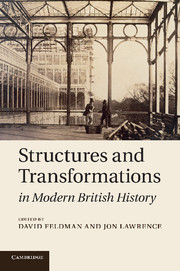Book contents
- Frontmatter
- Contents
- List of figures
- Notes on contributors
- Introduction: structures and transformations in British historiography
- 1 Coping with rapid population growth: how England fared in the century preceding the Great Exhibition of 1851
- 2 The ‘urban renaissance’ and the mob: rethinking civic improvement over the long eighteenth century
- 3 Forms of ‘government growth’, 1780–1830
- 4 Family formations: Anglo India and the familial proto-state
- 5 The commons, enclosure and radical histories
- 6 Engels and the city: the philosophy and practice of urban hypocrisy
- 7 The decline of institutional reform in nineteenth-century Britain
- 8 British women and cultures of internationalism, c.1815–1914
- 9 Psychoanalysis, history and national culture
- 10 Labour and the politics of class, 1900–1940
- 11 The dialectics of liberation: the old left, the new left and the counter-culture
- 12 Why the English like turbans: multicultural politics in British history
- Index
2 - The ‘urban renaissance’ and the mob: rethinking civic improvement over the long eighteenth century
Published online by Cambridge University Press: 04 February 2011
- Frontmatter
- Contents
- List of figures
- Notes on contributors
- Introduction: structures and transformations in British historiography
- 1 Coping with rapid population growth: how England fared in the century preceding the Great Exhibition of 1851
- 2 The ‘urban renaissance’ and the mob: rethinking civic improvement over the long eighteenth century
- 3 Forms of ‘government growth’, 1780–1830
- 4 Family formations: Anglo India and the familial proto-state
- 5 The commons, enclosure and radical histories
- 6 Engels and the city: the philosophy and practice of urban hypocrisy
- 7 The decline of institutional reform in nineteenth-century Britain
- 8 British women and cultures of internationalism, c.1815–1914
- 9 Psychoanalysis, history and national culture
- 10 Labour and the politics of class, 1900–1940
- 11 The dialectics of liberation: the old left, the new left and the counter-culture
- 12 Why the English like turbans: multicultural politics in British history
- Index
Summary
The ‘urban renaissance’ and the mob
Few concepts in urban history have been so influential in recent years as that of the ‘urban renaissance’. The expression was formulated by Peter Borsay in the early 1980s, and taken to denote the process by which civic leaders sought to bring greater order, decorum and beauty to civic centres by demolishing some of their densely packed, vernacular buildings and replacing them with wide open thoroughfares and new buildings made from modern materials. And despite the emergence of a large and growing literature on the eighteenth-century town in the past two decades, the existence of the urban renaissance still remains largely undisputed. Much of this work has focused on the physical improvements made to the urban infrastructure by the construction of new streets and buildings, the creation of parks, walks and gardens, and the introduction of street lighting. At the same time, however, this literature has shown itself sensitive to cultural components of urban change, stressing also the social opportunities offered by new urban amenities such as assembly rooms, inns and coffee houses and the role urban improvement played in forging a new civic identity. Furthermore, this account of the blossoming eighteenth-century town complements remarkably well a number of other themes that currently dominate the historiography of this period – the importance of politeness, for example, the rise of consumerism and shopping, and the emergence of the ‘public sphere’.
Keywords
- Type
- Chapter
- Information
- Structures and Transformations in Modern British History , pp. 54 - 73Publisher: Cambridge University PressPrint publication year: 2011
- 1
- Cited by

